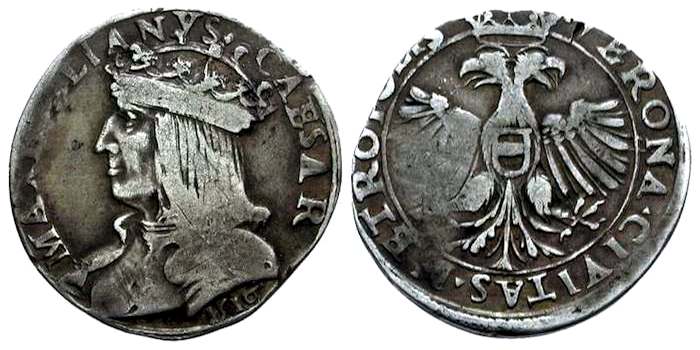
Teston 1516, Verona (1/3 guldiner). Ø 27 mm, 9,05 g. CNI VI p.279 n.3; Egg 4 (p.180) Obv.: MAXIMILIANVS·CAESAR - Crowned bust in armor, under the shoulder 1516. Rev.: VERONA▴CIVITAS▴METROPOLIS Crowned and nimbed double eagle with heart shield Austria. The lower die of the obverse has been preserved in the Tyrolean State Museum Innsbruck. [Egg, p.85]

Mezza lira n. d., Verona (1/2 testone). Ø 24 mm, 3,80 g. CNI VI p.281 n.13; Egg 6. Specimen in the Coin Cabinet, Staatliche Museen, Berlin 
Obv.: MAXIMILIANVS▴CAESAR - Crowned bust to the left, in armor. Below flower with stem. Rev.: ▴Sanctus▴ZENO▴PROTECtor▴ - VERONAE The standing saint Zeno from the front in bishop's robe with miter but without nimbus raises the right to the blessing. In the left hand crook and rod with a fish on the hook.

Mezza lira n. d., Verona (1/2 testone). Ø 24 mm, 3,76 g. CNI VI p.281 n.14; Egg 7. Obv.: MAXIMILIANVS▴CAESAR - Laurel bust to the left, in dress. Rev.: ▴Sanctus▴ZENO▴PROTECtor▴ - VERONAE The standing Saint Zeno as before. In der Linken Krummstab und Angel mit einem Fisch am Haken. Zeno of Verona, the city's patron saint, is said to have been a fisherman on the Adige River
before becoming Bishop of Verona.

Sesino n. d., Verona (6 denari). Base alloy, Ø 16 mm, c.1,2 g. CNI VI p.281 n.18; Egg 12. Obv.: MAXIMILIANVS▴CAESAR - Crowned bust to the left. Rev: S ZENO▴PROTEC▴VERONAE - St. Zeno, sitting to the right, wears miter and nimbus and bless with the right hand. In the background a crook and a rod with a fish on the hook. Smaller nominals carry the image of St. Zeno and the Austrian coat of arms. 
Bagattino 1516, Verona (denaro) copper, Ø 16 mm, 2,53 g. CNI VI 279/5; Egg 15. Obv.: ·S·ZENO·PROTeC·VERONAE· - Bust of St. Zeno, with miter, nimbus and date, without circle. Rev.: DVX AVSTRIAE - Crowned double-headed eagle with Austrian arms.

Bagattino n. d., Verona (denaro) copper, Ø 16 mm. CNI VI 281/20-24; Egg 21. Obv.: ▴S▴ZENO▴PROTEC▴VERONAE - Bust of St. Zeno, with miter, without nimbus, inside a circle. Rev.: DVX AVSTRIAE - Crowned double-headed eagle with Austrian arms.
Ref.:
• Corpus Nummorum Italicorum (CNI), vol. VI - CNI-Indici vol.VI 
• Erich Egg: Die kaiserliche Münzstätte in Verona in: Die Münzen Kaiser Maximilians I. Innsbruck (1971), p.84-86. excerpt: PDF 
• Hermann Wiesflecker: Kaiser Maximilian I., Band IV: Gründung des habsburgischen Weltreiches. Lebensabend und Tod 1508-1519. München 1981 • Schels, Johann Baptist: Bd.7: Zeitraum von dem Regierungsantritte des Königs Albrechts II im Jahre 1437, bis zum Tode des Kaisers Maximilian I. im Jahre 1519  (1825), online bei Google (1825), online bei Google
• Stefan Schweizer: Zwischen Repräsentation und Funktion: die Stadttore der Renaissance in Italien. Göttingen 2002, bei Google  , siehe S.236f , siehe S.236f |
 start page
start page